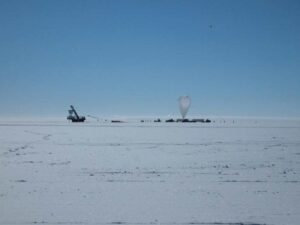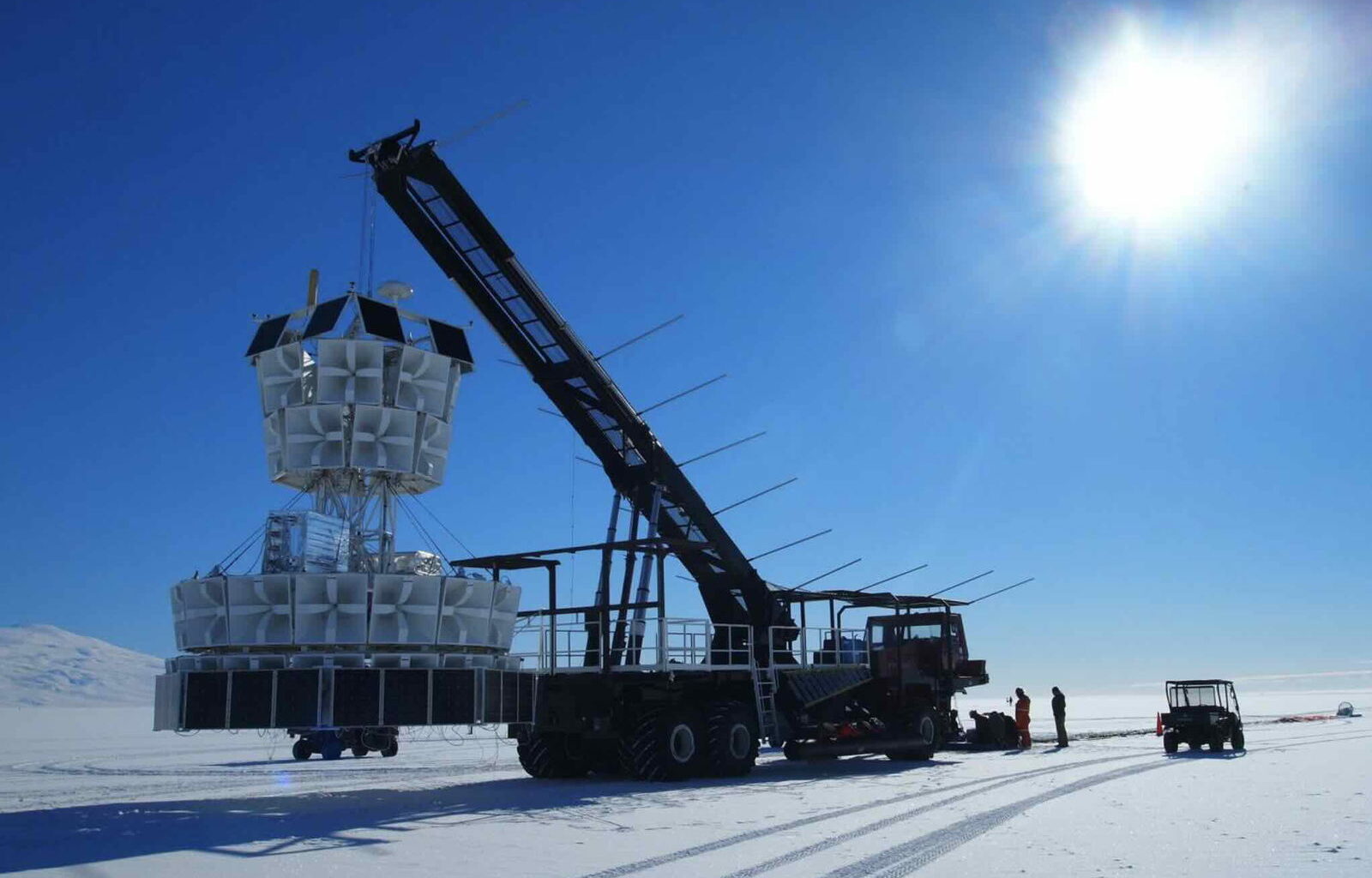Penn State scientists using balloon-mounted cosmic particle detectors to analyze radio waves from cosmic rays on the remote continent of Antarctica report the anomalous detection of strange radio pulses that seem to originate from below the ice.
A statement announcing the anomalous detections says these “bizarre signals” defy the current understanding of particle physics and may hint at previously undiscovered particles or particle interactions.
“It’s an interesting problem because we still don’t actually have an explanation for what those anomalies are,” said research team member Stephanie Wissel, an associate professor of physics, astronomy, and astrophysics and the study’s lead author.
Hunt for Neutrinos in Antarctica Detects Strange Radio Pulses
The research team says detecting pulses seemingly originating from beneath the Antarctic ice was undoubtedly exciting. However, they say they were in the middle of an experiment searching for neutrinos, and the discovery was a lucky accident. Elusive particles without an electrical charge and the smallest known mass of all subatomic particles, neutrinos, are typically emitted by extremely high-energy sources like stars and supernovae. Even though models indicate they are plentiful in the universe, they have been virtually impossible to detect since they rarely interact with other types of matter but pass right through it.
“You have a billion neutrinos passing through your thumbnail at any moment, but neutrinos don’t really interact,” Wissel explained. “So, this is the double-edged sword problem. If we detect them, it means they have traveled all this way without interacting with anything else.
Several experiments placed in remote locations to minimize interference are currently attempting to detect neutrinos, including the Antarctic Impulsive Transient Antenna (ANITA) experiment. Unlike detectors deep underground or in an isolated laboratory, ANITA uses balloon-mounted particle detectors to search for “ice showers” created by neutrino interactions.
 ANITA was placed in Antarctica because there is little chance of interference from other signals. To capture the emission signals, the balloon-borne radio detector is sent to fly over stretches of ice, capturing what are called ice showers. Image Credit: Stephanie Wissel / Penn State.
ANITA was placed in Antarctica because there is little chance of interference from other signals. To capture the emission signals, the balloon-borne radio detector is sent to fly over stretches of ice, capturing what are called ice showers. Image Credit: Stephanie Wissel / Penn State.
“We have these radio antennas on a balloon that flies 40 kilometers above the ice in Antarctica,” Wissel said. “We point our antennas down at the ice and look for neutrinos that interact in the ice, producing radio emissions that we can then sense on our detectors.”
During those sweeps, the team recorded a series of radio pulses. However, unlike the expected detection of neutrino interactions caused by cosmic neutrinos, the team saw bizarre radio pulses originating from the other direction.
“The radio waves that we detected were at really steep angles, like 30 degrees below the surface of the ice,” said Wissel.
Detections Are Not Neutrinos, Remain Unexplained
After confirming the anomalous detections, the team performed several calculations intended to help pinpoint the pulses’ origin. According to Wissel, those calculations indicated that the signals had to pass through and interact with thousands of kilometers of solid rock before reaching the ANITA detectors. If correct, the rock should have absorbed the signals, preventing them from reaching the detectors.
The team compared the ANITA readings with mathematical models and “extensive” simulations of regular cosmic rays and other upward-going air showers to confirm they weren’t detecting a neutrino or some other known particle-based signal. This effort allowed them to filter background noise and eliminate known signal sources.
Although the results didn’t match any known sources of radio pulses originating from beneath the ice, Wissel said the results indicate that “they’re most likely not representing neutrinos,” Wissel said.
The team also cross-referenced the strange signals with detections made by independent efforts such as the IceCube Experiment and the Pierre Auger Observatory. These comparisons found no similar events, leading Wissel and the team to describe them as “anomalous.”
“My guess is that some interesting radio propagation effect occurs near ice and also near the horizon that I don’t fully understand, but we certainly explored several of those, and we haven’t been able to find any of those yet either,” Wissel said. “So, right now, it’s one of these long-standing mysteries.”
Future Analysis Could Solve the Mystery
Because the strange radio pulses coming from beneath the ice don’t align with the standard model of particle physics, the team says several other explanations are possible. One concept says the team detects evidence of dark matter, while another says it may be an entirely new type of particle or particle interaction.
Wissel suggests that follow-up observations by Auger and IceCube may “narrow possibilities.” She also noted that her team is currently building a new, larger, and more sensitive detector called PUEO. Once finished, it may help solve the mysterious detections.
“I’m excited that when we fly PUEO, we’ll have better sensitivity,” she said. “In principle, we should pick up more anomalies, and maybe we’ll actually understand what they are.”
“We also might detect neutrinos,” Wissel added, “which would in some ways be a lot more exciting.”
Christopher Plain is a Science Fiction and Fantasy novelist and Head Science Writer at The Debrief. Follow and connect with him on X, learn about his books at plainfiction.com, or email him directly at christopher@thedebrief.org.

